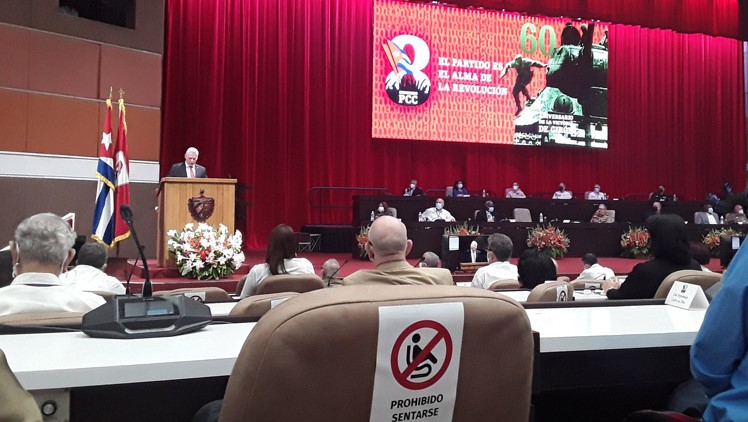On April 19, 2021, at the close of the 8th Congress of the Communist Party of Cuba (PCC), 14 people were elected to form the new Political Bureau, the highest body charting the island’s course and making most of important political decisions affecting Cubans.
By simple mathematics, each member of the Political Bureau, thus, endows himself with the right to speak, act and decide for 809,044 citizens. When one recalls that this party entity is the top leadership body in the PCC, the ultimate ideological and political authority of the Party and the Cuban State, and that it has both legislative initiative and the power to propose government positions, he understands that its composition reflects the representative democracy index prevailing in the country.
Cuba's non-members, approximately 93.5% of its population, are, thus, subordinated to 14 individuals who hold in their hands the destinies of an entire populace. Put another way, this powerful group represents 0.00012% of the 11,326,615 Cuban people, the country’s estimated population at the end of 2020, according to official figures.
If we take into account that in February 2019 there were between 8.7 and 9.2 million Cubans with the capacity to vote (a figure that the National Electoral Commission of Cuba, chaired by Alina Balseiro, altered, without any explanation) 14 people represent between 0.00016% of this subgroup.
As stated in Article 5 of the current Constitution, the PCC, through its Political Bureau, and not the rank and file, calls itself the "organized vanguard of the Cuban nation."
From the constitutional point of view, the fundamental duty of this group of people is to "organize and guide common efforts in the development of socialism and progress towards a communist society."
Today, the Political Bureau is made up of the President of the Republic and the President of the National Assembly of Popular Power (ANPP), Miguel Díaz-Canel and Esteban Lazo, respectively; the prime minister or head of the government in Cuba, Manuel Marrero; Havana's Foreign Minister, Bruno Rodriguez; and the secretary of the Council of Ministers, General Jose Amado Ricardo Guerra - the latter two, to keep a close eye and tabs on all the former, all amidst a shroud of secrecy.
Of course, the fraud and charade would not be complete without two of the regime’s three largest mass organizations - the Federation of Cuban Women (FMC) and the Central de Trabajadores de Cuba (CTC) – being represented in the body, which must appear, at least, to defend the interests of workers, in general, and women, in particular.
In a complex world, threatened by rare pandemics whose origins are still unknown, it is sensible, strategically, to include the country's most technologically advanced scientific center in the Bureau. Hence the inclusion of Marta Ayala Avila, director of the Center for Genetic Engineering and Biotechnology (CIGB). It is prudent to promote and protect the production of medicines and their export in a world that is increasingly exposed to illness and affected by the environment.
Similar considerations are behind the inclusion of the powerful military business sector, represented by Luis Alberto Rodríguez López-Calleja, connected to the Castro family and a representative of its productive experiment in the area of dollars through the GAESA business consortium.
For his part, Interior Minister Lázaro Alberto Álvarez Casas is the visible spearhead of the State’s repressive and coercive functions. Above him, however, looms the all-seeing, forceful Army General Alvaro Lopez Miera, Minister of the Revolutionary Armed Forces (FAR) and the right-hand man of Cuba’s highest-ranking officer: General Raul Modesto Castro Ruz.
Gladys Martinez Verdecia, first secretary of the Provincial Committee of the Party in Artemisa, meanwhile, cannot be, among the 14, just another number, or a simple representative of the female sex. Artemisa, after all, is the site of the unfinished strategic development project that is the Mariel Special Development Zone. It is logical that the highest level should have control over the situation there.
None of the aforementioned are members from the rank and file. And there are no workers, or agricultural laborers, which would accord with the socialist model. Of them, only three (21.4%) are women, and only two (14.2%) are black.
What model of democratic representation does this "select" group exhibit, then? According to the constitutional principles in force in Cuba, it is supposed to act for "the good of all" and represent the "highest leading force in society and the State."
A simple examination of the composition of the Political Bureau leads one to the conclusion that there is no division in Cuba between the State’s political and structural powers. In other words, there is no possibility of any counterbalance between the country’s highest leadership body and its civil service structure, which is supposedly, and allegedly, elected or appointed by the people and their representatives without the Party’s intervention.
